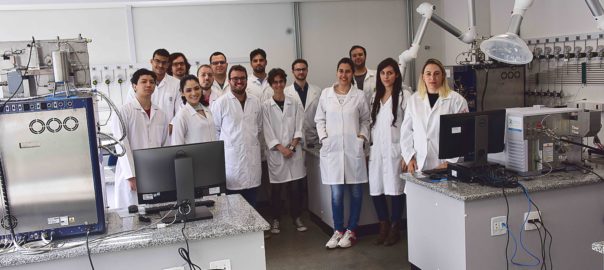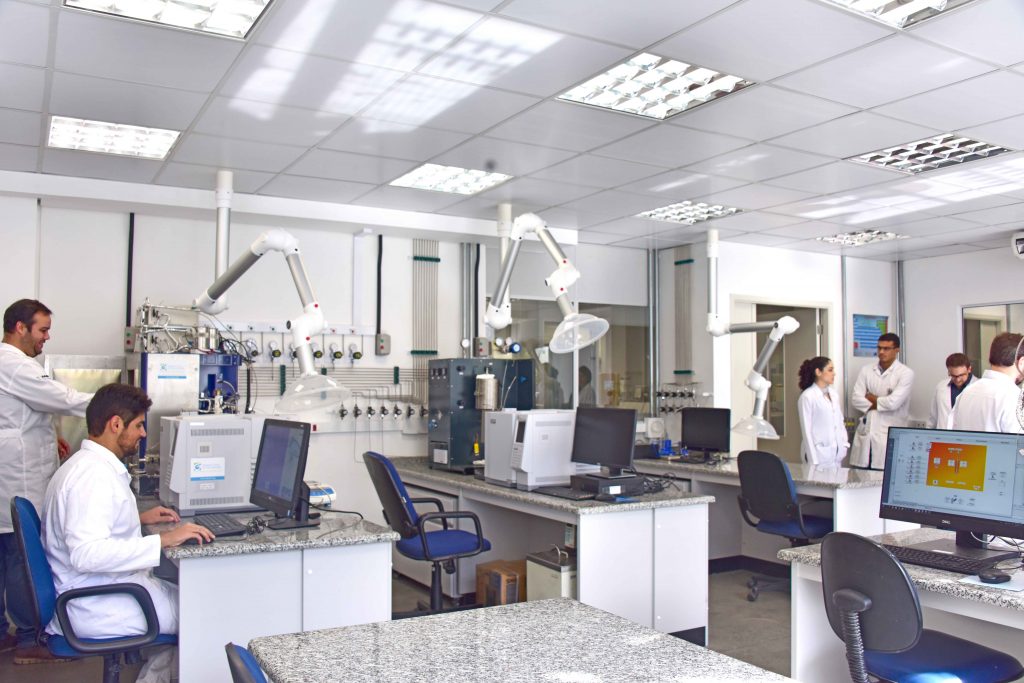One of the lab’s goals is to develop catalysts for reactions that use CO2 as a raw material; RCGI helped fund the new facilities
The Laboratory for Research and Innovation in Catalytic Processes – LaPCat, of the Chemical Engineering Department of the Polytechnic School of USP (PQI-POLI-USP) was inaugurated in São Paulo. The event took place from 10am to midday and started with a presentation made by professors Martin Schmal, Rita Maria de Brito Alves and Julio Meneghini, from the Polytechnic School of USP, at the Priscila Aya Shimizu Amphitheater, in Block 19 of the PQI-POLI/USP, Conjunto das Químicas, Campus Butantã. Afterwards, a guided visit to the laboratory was made and, after the “tour”, a cocktail will be offered to the guests.
The facilities are located in block B, first floor of the building known as Semi Industrial, attached to the Chemical Complex at USP, in a 400 m² area that also houses the Polymer Laboratory, coordinated by professor Reinaldo Giudici. “We carried out a renovation, and made a common area for both research groups: polymers and catalytic processes. This common area houses spaces for preparation, calcination, physical, thermal, chemical and in-situ characterization, etc. Separately, each of the research groups has exclusive spaces for the development of their specific activities. We also have an area for future installation of pilot plants, because later the processes we are experimenting on the bench can be tested on a larger scale”, summarizes the professor.
Rita, who is vice-coordinator of the Physical Chemistry Program and project coordinator at FAPESP Shell Research Centre for Gas Innovation (RCGI), explains that in the new laboratory catalysts are developed for some reactions and processes, such as the tri-reforming of methane to produce synthesis gas (syngas) for use as feedstock for fuels and chemicals, the Fischer-Tropsch reaction for production of fuels, light hydrocarbons and olefins, the reaction known as Water Gas Shift for hydrogen production, and the CO2 hydrogenation reaction for production of DME (Dimethyl Ether), which can be used as a fuel.
Consultant for the laboratory, catalysis expert professor Martin Schmal, Collaborating Professor at Poli/USP (and Emeritus Professor at COPPE/UFRJ), emphasizes that the most important thing is the study of new materials for the development of catalysts. “This is the differential. I have been working for 40 years in catalysis, and I have always researched different types of materials: graphene, carbon nanotubes, mixed oxides. The use of these materials for catalysts is very recent in the world. Chinese and Europeans, especially Italians and Germans, are very advanced in this area of study.
According to him, these catalysis technologies are not yet being used by the industry. “The studies are advancing, which does not mean that catalysts based on these new materials are already being applied in industry at the present time. However, we believe they have a future.”
CO2 abatement – Both methane tri-reforming and DME production use CO2 as feedstock, and therefore can be considered as CCU (Carbon Capture and Utilization) initiatives. CCU has been pointed out as one of the promising ways to reduce CO2 emitted by anthropogenic processes in the world.
According to Rita, the CO2 used as raw material for the reactions studied can come from several sources, including: the Pre-salt, which has a natural gas rich in CO2; from a thermoelectric plant; from fermentative processes, or from biogas.
“A good part of the research groups that work with the CO2 abatement theme, on a global level, are investigating processes to transform it into high value-added products. Thus, CO2 ceases to be waste and becomes an input, a raw material. I think that CCU and Carbon Capture and Storage (CCS) are not mutually exclusive, but complementary, and therefore it is more appropriate to refer to CCUS (Carbon Capture, Use and Storage),” she opines.
Schmal recalls that biomass can deliver various products through different processes, and that the development of catalysts for the reactions intrinsic to such processes is a necessity. “There are a lot of people studying, for example, sugarcane bagasse; a lot of people studying obtaining high value-added products from biomass pyrolysis. But it is necessary to treat and purify the products obtained. And, for this, specific catalysts are often needed.”
Testes and processes – The team using the laboratory, 20 people in all in the experimental part alone, is already in the testing phase to verify whether the catalysts developed are ideal for the reactions to be improved. According to Rita, the best results with the catalysts synthesized by the group, so far, were obtained for the methane tri-reforming process.
“When the catalysts have good results, we continue testing: different pressures, different temperatures… This is done to gather experimental data and model the reaction kinetics. With the kinetic data, it is possible, through process modeling and simulation, to design the reactor, because it is the reaction kinetics that define this design. From there, the global process can be designed, defining the mass and energy balances, the best operation condition, the separation processes of the reaction products, the purification of the desired compounds…”, explains the engineer from Poli/USP.
According to her, many of the studies developed in the new Laboratory are starting from scratch. “We want to deliver technically, economically and environmentally viable processes that emit less than they consume. Having an environmentally sustainable process is important. So after creating the catalyst, testing its catalytic activity, developing the kinetic model, process design, etc., we also evaluate the process from the point of view of energy consumption and environmental impacts. Finally, we compare it with conventional routes used to deliver the same product, because new processes have to be shown to be viable against existing ones.”
Most of the funding to refurbish the Catalytic Processes Research and Innovation Laboratory came from the São Paulo State Research Support Foundation (FAPESP). Shell, through RCGI, also helped fund part of the facilities, which also received funds from other projects developed by the team that coordinates the space.
Partnerships – Professor Schmal points out that the laboratory is very up-to-date and modern, with highly sophisticated, precise, and sensitive equipment. It is a multi-user laboratory, open to researchers from USP and other universities, but also to partnerships with the private sector through research projects.
“We are prepared to do advanced studies in terms of development, but we are also able to do applied studies for industry. A few weeks ago we were approached by a chemical company from São Paulo to do a project. We are outlining the terms of the partnership,” he said.


